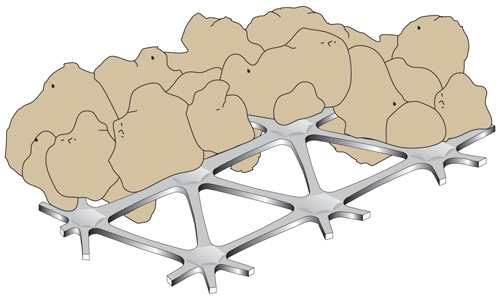Geogrid is a plate with a structure consisting of fibers (Ribs) that are perpendicular to each other (longitudinal and transverse or MD and (CMD or non-perpendicular) connected in various ways at points called junction points. Geogrid is a type of geosynthetic that is made of a set of polymer strips connected to each other that are placed next to each other in the form of a network. Between the strips of the geogrid network, an empty space with appropriate dimensions is embedded to increase the effect of surrounding soil, rock and other geotechnical materials. Therefore, geogrids are polymer mesh networks in which empty spaces of different dimensions called springs are observed. The dimensions of the springs vary between 10 and 100 mm. The strips used in the manufacture of geogrids are placed next to each other in two main directions called longitudinal and transverse, respectively. The strips are made of various polymer materials such as polypropylene, polyethylene and resistant polyester fibers. How to pass or connect Polymer strips are connected to each other at different points or nodes. Considering the appearance, structure and strength of geogrids, it is clear that their first and perhaps most important function is to strengthen and reinforce embankment layers, soil bed and other geotechnical materials.
Double-sided geogrids are specially designed for stabilizing and reinforcing soil and are made of polypropylene and are stretched from both sides to increase tensile strength during production. This type of geogrid has very high tensile strength and resistance to damage during installation. The interlocking of granular particles between the holes causes the soil to be enclosed and reinforced.
It is a network of polyester tensile components with a polymer coating that, due to its special design, texture type and dimensions of the springs, creates maximum interaction with the surrounding materials. This product is produced using the latest manufacturing technology and the best raw materials and has approval from reputable laboratories.
Bi-directional multilayer geogrids are a polypropylene composite that is obtained by combining a certain number of layers of one or more geogrids. This product can be produced with different stability and different characteristics that are required by the design. Standard multilayer geogrids are obtained by combining up to five layers of lightweight flexible geogrids. This combination creates a high resistance that will be able to withstand very high loads and is used to stabilize soils with large pores and cavities caused by local settleme

nt.